Notification sounds are an essential part of an operating system. Whenever there is an important action performed, Windows by default provides feedback to the user through notification sounds. We hear notification sounds for most common actions like connecting or disconnecting a USB device, battery low alert, calendar reminders and so on. We have already seen how to change the sound in Windows. This tutorial shows you how to disable or turn off Notification & System Sounds in Windows 11/10.
Windows 11/10 comes shipped with a new set of sound notifications, some are borrowed from Windows 8.1. Windows 11/10 has a new set of sound alerts for events like Calendar reminders, Messaging, Emails, Volume changes, etc. There is a way to customize the system tones according to your preferences. You can even turn off sound for all system alerts in Windows by changing a few sound settings on your PC.
Click on the Speaker icon in the taskbar and move the slider to change the volume of the sound.
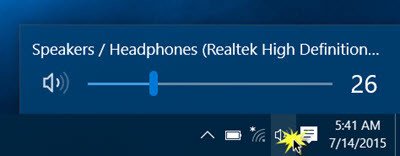
Turn off System Sound in Windows 11/10
In order to be able to turn off system sounds in Windows 11/10, you will have to open the Sound settings. Right-click on the Speakers icon which is present at the right side of the taskbar.
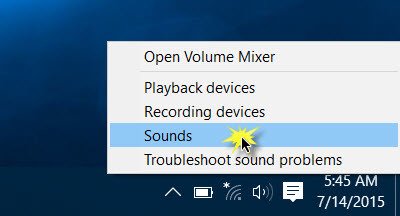
You will see “Sounds” or “Sound settings” option in the popup. Click on it.
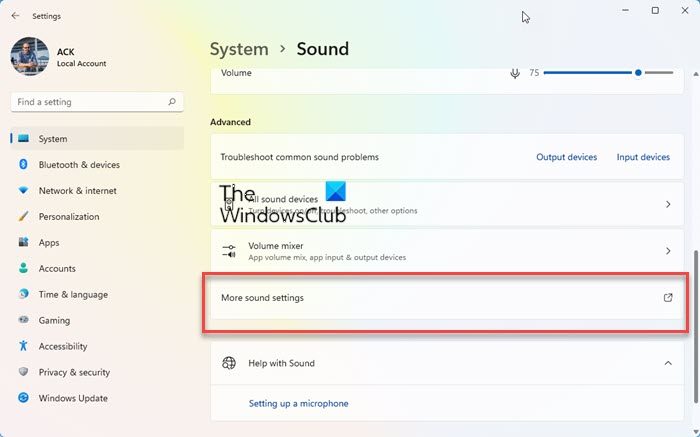
In Windows 11, Sound Settings will open. Here you will have to click on the More sound settings link to open Sound Properties box.
In Windows 10 the Sound Properties box will directly open.
This box provides a variety of options to customize sounds according to your needs. Browse through the list of available program events and choose the one which you intend to change or test. After choosing a particular sound for an event in the “Sounds” section, click on the “Test” button to playback the same.
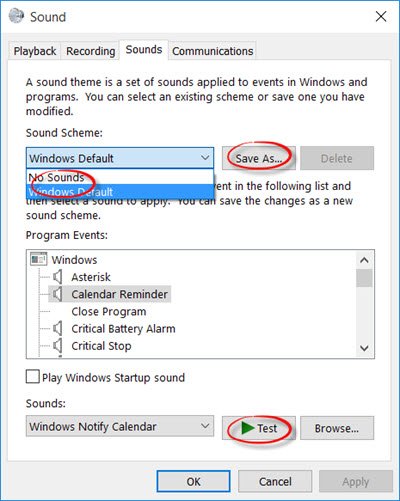
This way you can modify the sound for any of the events. Following are the list of a few events, to which you can set the sound:
- Asterisk
- Calendar Reminder
- Critical Battery Alarm
- Desktop Mail Notification
- Device Connect
- Device Disconnect
- Instant Message Notification
- Low Battery Alarm
- New Fax Notification
- New Text Message Notification
- System Notification
- Incoming calls and more.
Read: Random Notification Sound keeps playing.
Saving Sound Schemes in Windows 11/10
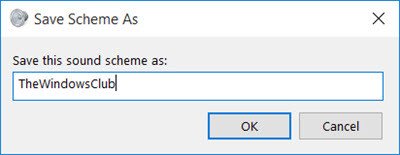
The modified sound settings can be saved as a scheme and can be switched according to your needs. In order to save changes, you made to events, click on “Save as” button and assign a name, so that you can use it for now or for future use. You can always go back to the default sound settings by choosing the “Windows Default” option in the sound schemes section.
In order to turn off, all system sounds in Windows 11/10, select the “No Sound” schema and save the sound settings as shown in the image. This should completely disable all system notification sounds.
TIP: You can set custom notification sound in Windows.
Turn off Notification Sounds in Windows 11/10
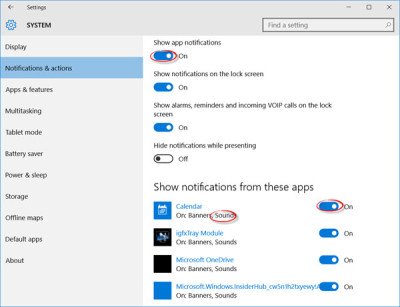
Apart from system notifications in Windows 10, there are apps that send sound notifications with banners that land in Action Center. For example, breaking news applications sends toast notifications (banners) along with sound whenever there is a piece of breaking news.
You can turn off notifications from these apps by heading to Settings app > System > Notifications. Just use the toggle under “Show app notifications” and turn it off. This should disable all notifications including Sounds from installed Windows Store apps.
You can also restrict a specific app from sending notifications by individually turning off app notifications using the same settings panel. You can either block complete notifications from the app or block particularly “sound” by turning off “Play a sound when a notification arrives” option – this results in silent app notifications which in turn pile up on your action center.
To completely disable all notification sounds for all the apps, move the slider for Show app notifications to the Off position.
In Windows 11, you will see these settings here:
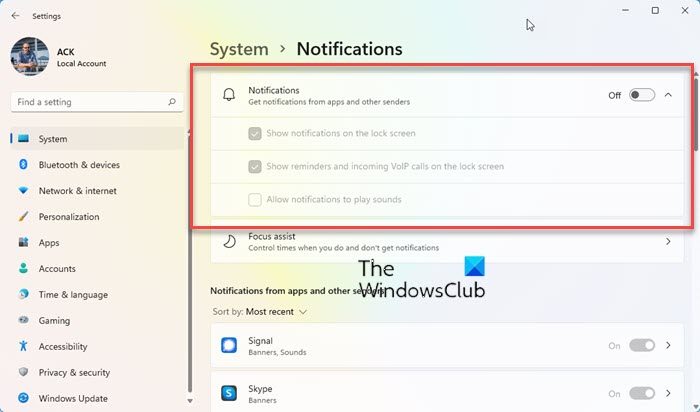
Turn off the slider against Notifications.
Now read how you can adjust the volume for individual programs in Windows 11/10.
The sound effect for volume changes isn’t on that list? It’s the only one I want to turn off, really..
searching the same
It’s “default beep”. Set it to none and that stops the volume control, side effect of stopping all apps that just play the default beep for things (almost all of them).
I have my sounds settings set to none, and I still get a super annoying default tone whenever I change volume or put a video or something in full screen.
I have literally everything turned off. All notifications and all sounds, and still the sounds persists.
same with me, i cant turn of annoying sound,
it just keeps bringing them back.
I set sound to NONE, and whatever i do next it brings the sound back,
what the hell is wrong with you windows, first you unable classic theme and now i have to listen PING, CLING and other idiotic sounds….
I just really want to make it LESS loud. It’s so annoying. The “beep” (it’s nothing like a beep in Windows 10″ is so much louder than anything else, I feel like it doesn’t give an accurate reflection of the true volume level.
Have done the “To completely disable all notification sounds for all the apps, move the slider for Show app notifications to the Off position.” but when I tell my computer to “sleep” and then log back on, the app has gone back to its original default setting of On, and I can’t find a way to make it save the settings as there is no Save tab.
Thank You so Much!
I just upgraded from Windows 7 to Windows 10. I have many annoying sounds, and can’t figure out what they are notifying me of. Thanks for this advice, I hope it will work. “None” sounds good, with one or two exceptions tolerated after I find if that works. What a waste of a user’s time.
Hi,Plz guide me.Upgrading from Win 7 to Wind 10,will our files be save or not?
My experience has been a) files were not lost, b) problems with “permissions”, i.e. saving files or changing files in my C (root) drive. c) annoying characteristics – such as sound problems, pages that are supposed to be providing we with options but are blank, work I have to do to get my old programs accessible so I can run them. d) some really annoying things that make life more difficult, for no reason. For example, in Windows 7 if you copy a file and try to save it to a folder that already has a file of the same name, then you are offered a choice – copy over, don’t copy or copy with a different name. That same procedure in Windows 10 does the same thing, but explains more and adds another step – another click – to do the work. Why somebody thought it was a good idea to introduce another click to do something that I find is a common task is beyond me.
Thanks
Thank you for this, was really tired of hearing the USB connect/disconnect sounds all the time.
Thanks man!
Microsoft updated my pc to Windows 10 on 9/15/16. The above explanation is invalid on my computer.
Instead, go to SETTINGS–>THEMES–>ADVANCED SOUND SETTINGS. From there you’ll get the familiar Sound properties tab. You can NOT search for “sound” and hope to find it.
Just one of hundreds of anti-intuitive modifications from Microsoft.
If you are on Windows 10 and have issues with “No Sounds” being changed back to Windows Default, it’s worth knowing about this: If you change windows Theme the “Sound Scheme” is also changed!
I did this and I also turned off all email notifications but still get beeps and do not know why. They sound like incoming email beeps. I do not know how to turn them off so I can hear the presentations for school.
Incorrect. You have always been able to change the sound profile in Windows by right-clicking the speaker icon in the notification tray. It goes to the exact same settings that you describe.
So guys i finally found a solution. Well, its more of a work around that disables windows from doing what it wants to do as it no more knows the path of the file
So here is what you need to do-
Go to
C:Windows
and locate the folder “media”
Rename the folder to “media1” (or anything of your preference, it basically needs to be renamed to anything except media)
FIN!
That’s literally all you need to do! and you won’t hear any of those annoying notification sounds irrespective of whether your earphones are plugged in or not.
You’re welcome :)
Yeah? And just how do I go to “C:Windows”?
On occasion, I am getting an odd notification, kind of like an acoustic keyboard sound, with several beeps or rings to it…it is very odd because it is sporadic and does not happen all the time. I just got this new machine with Windows 10 so it only started after using this computer. I have disabled all notifications that I am aware of but these funky sounds keep popping up. Any insight would be appreciated! Thanks.
thank you so much. now i can watch youtube in peace without win10 blowing out my eardrums